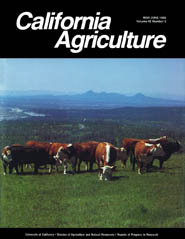Calag Archive
Calag Archive

Cover:
Productivity of plants and animals on a lush, fertilized legume pasture of the Sierra Foothill Range Field Station was substantially improved in a three-year study. The most profitable approach was seeding with sub and rose clovers and fertilizing with phosphorus and sulfur. Cover photo by Charles Raguse
May-June 1988
Volume 42, Number 3
Volume 42, Number 3


